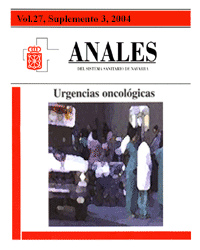The oncology patient in emergencies. Epidemiological data
Keywords:
Urgencia oncológica. Causa de consulta. Motivo de ingreso.Abstract
Oncology patients do not form a large proportion within the overall figures of an emergency service, but their clinical characteristics mean that attending to them is often complex. The elaboration of a complete clinical history, specifying the characteristics and stage of the tumoural disease, is a basic weapon for taking decisions when an emergency arises. According to the data from our centre, oncology patients account for 5% of the total of emergency cases. The most frequent type of tumour that we deal with is pulmonary, followed by breast and colon. It is often the case that these patients come to the emergency department several times in the same month and pain is the most frequent reason for consultation, although it is normal for them to mention several causes on each occasion. In a high percentage of cases the reason for the consultation is related to the disease itself, but on as many as 35% of occasions it is an intercurrent pathology. The index of admissions is high (around 50%), especially if the patient has come for a reason related to the disease. In global terms, they account for 14% of total admissions from emergencies.Downloads
Downloads
Published
How to Cite
Issue
Section
License
La revista Anales del Sistema Sanitario de Navarra es publicada por el Departamento de Salud del Gobierno de Navarra (España), quien conserva los derechos patrimoniales (copyright ) sobre el artículo publicado y favorece y permite la difusión del mismo bajo licencia Creative Commons Reconocimiento-CompartirIgual 4.0 Internacional (CC BY-SA 4.0). Esta licencia permite copiar, usar, difundir, transmitir y exponer públicamente el artículo, siempre que siempre que se cite la autoría y la publicación inicial en Anales del Sistema Sanitario de Navarra, y se distinga la existencia de esta licencia de uso.








